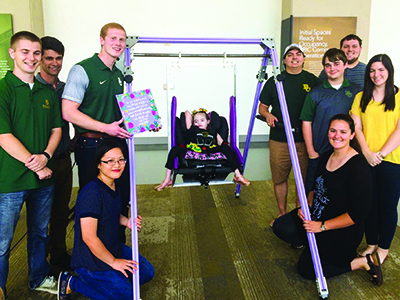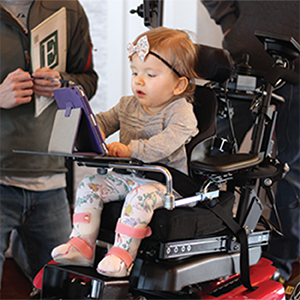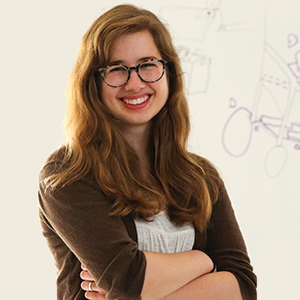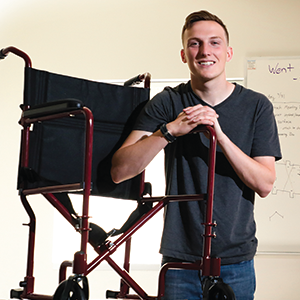Engineering Pursuits with a Higher Purpose
Students of Baylor's School of Engineering and Computer Science use their talents to help enrich the lives of children with special needs.
It all started with a casual conversation between friends.
Dr. Jason Whitt, associate director of Baylor’s Institute for Faith and Learning, and Dr. Ian Gravagne, associate professor of electrical and computer engineering, were on a hike during a faculty retreat a couple summers ago when Gravagne told Whitt about the Senior Engineering Design program in which multidisciplinary teams of students from the School of Engineering & Computer Science (ECS) work on open-ended projects, identifying a need and designing a product to meet that need. Whitt remarked that such projects have the potential of helping children with special needs who rely on assistive devices to improve their everyday quality of life. This is the kind of connection that comes naturally to Whitt, for his daughter, Camille, now age eight, has a progressive neurological disorder that limits her development to the level of a 4 to 6-month-old.
While Whitt was not thinking specifically of the needs of his own daughter that day but, rather, generally of the needs of children like her, the seeds of something wonderful had been planted, and what would quickly grow from that conversation would impact the lives of many more people in meaningful ways when a community of ECS students and faculty teamed up for a capstone project with one goal: to help enrich the life of a special little girl named Camille through the creation of a custom swing.
“I met Dr. Jason Whitt through my involvement with the Institute for Faith and Learning at Baylor. As I got to know him better, he spoke more of his daughter’s condition,” says Gravagne. “On one occasion, he pointed out that motion—in particular, swinging motion—is enjoyable and soothing for Camille, but swings designed for infants and toddlers would not be large enough or safe for someone of Camille’s size. I pondered this for a while and eventually decided that our Senior Engineering Design students could tackle the problem, though it might take a few iterations.
“The Senior Engineering Design course is structured so that students can take a need like Camille’s, translate that need into engineering specifications, design components to meet those specifications and—ideally—construct a prototype of the design,” explains Gravagne. “This design presented two principal challenges: making sure the swing would be structurally and dynamically safe—not tip over—for a small adult and building an electrical actuation system to keep the swing moving.”
‘Swinging’ Into Action
Over the course of two years, three teams of students that included mechanical engineering majors, electrical and computer engineering majors, and general engineering majors worked on the project.
“It really took working through the three semesters to iron out the various challenges to get a working swing,” notes Dr. Brian Garner, associate professor of mechanical engineering, who served as the faculty lead on the project. “One of the challenges is that, compared with the baby swings, the big kids’ swing is much taller and must be capable of swinging children that may weigh up to around 100 pounds. So the structure, motor [and related components] need to be more heavy-duty. Another challenge is configuring and controlling a motor, which wants to just rotate, to drive that swinging motion which is back and forth. It may seem like an easy thing, but practically speaking, it was a challenge to get that to work properly and also accommodate multiple swinging heights—for example, high and low settings. Another challenge was getting some specific parts, such as a coil torque spring, that fit the needs the design had. In the end, the students found a suitable spring out of an old emergency brake handle.”
All the members of the student teams had the honor of meeting Camille and her family, and by simply talking with them, they were able to better understand how they could apply their talents to serve Camille’s needs best. “After each meeting, students almost universally agreed that it was a profound moment, to tangibly understand how their skills can help people and how engineering can at times be a direct expression of love and compassion,” says Gravagne.
That love and compassion was immediately evident to Whitt and his family from the initial meeting. “During that first meeting, the students didn’t want to know about specifications, but they wanted to know about Camille’s life and our life as a family,” Whitt says. “I remember this really big guy—not the type I expected to be thinking about anything but the specs of the project—raised his hand to ask the question, ‘What’s Camille’s favorite color?’ At that moment, I knew that ECS was forming these students right. That moment encapsulated to me that we’re not only shaping excellent engineers but also students of excellent character. They get the Baylor mission that all we do is animated by faith in Christ.”
It was an inspiring experience to meet Camille, says Garner, especially for the third and final team of 10 students that had the privilege of delivering Camille’s Swing—which is her favorite color of purple and adorned with stickers of her favorite Disney princesses—to Camille and her family on a spring afternoon last year at the Baylor Research and Innovation Collaborative (BRIC). “All the students experienced a great deal of joy and satisfaction at seeing Camille’s beaming smile as she swung on her swing for the first time,” he says. “I know all the students signed up for the project because they had a passion to serve and help other people, and I think it turned into as much a blessing for them as it was for Camille and her family. I hope for the students, the project was an opportunity to grow and learn not only in the technical realm about how to design and build a working product but also how to overcome adversity, to persevere and to experience the blessing of serving others.”
That sentiment certainly rings true for Kimmie Sandusky, who was a member of that third team. “Seeing Camille swinging in her swing was the best moment of my life,” says Sandusky, who graduated with a BS in engineering last year and now works as a project engineer for a construction company in Scottsdale, Arizona. “Engineering has always been about using the skills that God has given me to help others. This experience helped me realize that anything that you do can be used to improve other people’s lives—even if you think they could be considered trivial. Camille’s Swing brings more comfort and peace to Camille’s life, and I’m grateful for being part of making that a reality for Camille and her family.”
Camille’s Swing and the students who brought it to fruition are a blessing, indeed, says Whitt. “To watch Camille in her swing is amazing. The first time she was swinging in it at the BRIC, she was squealing in delight, and her laughter was echoing off the walls,” he says. “The students chose [this project] because it helped a little girl. People ask, ‘What’s it for? Is it therapeutic? What does it allow or do for her?’ I answer, nothing. It doesn’t do anything in that sense, but its worth can’t be measured in those terms. Its value is what it offers her. It simply brings joy to Camille and our family, and that’s the beauty of what the students did. If it mattered to one little girl, it mattered to them. They cared about us as a family, and they love Camille. Camille’s Swing is incredible not just because of the hoops that the students had to get through to build it but because it was a project of love.
“Camille’s Swing remains a treasure at our house,” adds Whitt. “It’s a blessing to us and reminds us of what’s so special about Baylor students and why Baylor’s mission matters.”
And the mission continues. Using Camille’s Swing as a model, another group of students is working on a similar swing for the Ronald McDonald House in Dallas, which could serve as one more step toward the goal of bringing a big kids’ swing to the market.
Setting the Wheels in Motion
Such success might be reason enough to rest on one’s laurels—but not for students and faculty of ECS. In fact, several teams of students are currently working on projects to serve others in need; among them is a team composed of five mechanical engineering majors and two electrical and computer engineering majors who are developing a child mobility aid for a precious two-year-old girl named Emmeline Pope.
Emmeline has Spinal Muscular Atrophy (SMA), a rare neuromuscular disorder that makes it difficult for her to move. Emmeline, who is happy and bright, needs help to be able to explore her environment and interact with other children. Currently, she uses five different devices at home, including an adult-size power chair weighing more than 300 pounds, and these devices don’t fill the gaps in meeting her everyday needs. Emmeline knows where she wants to go but needs help getting there—and this is where the Senior Engineering Design students enter the picture, says Joe Donndelinger, clinical professor of professional practice, who is the faculty mentor for this Capstone Design team.
“We see opportunities in this area because the options on the market are limited, they’re expensive, and they don’t fully meet the family’s needs,” says Donndelinger. “I’m sensitive to these issues because my brother-in-law has the same disease; he cannot walk or stand on his own. I’ve worked with my sister’s family for over 30 years as they have struggled to find suitable assistive devices, struggled to keep them working, and struggled to pay for them. Insurance coverage for mobility aids can also be quite complicated. In Emmeline’s case, the insurance company asked her to demonstrate that she could use the mobility aid before they would pay for it, creating a ‘catch 22.’ Many families like the Popes find themselves in similar situations with insurance coverage.”
To help Emmeline gain the independence and freedom to socialize, the students are working to develop a lightweight, child-size mobility system that will allow Emmeline to operate the aid with precision control and minimal effort. It needs to include the option to quickly convert into a power-mobility system when she gets tired; have a small profile to provide unobstructed space conducive to natural interaction; be capable of navigating over carpet; be easily moveable into and out of the family’s vehicle; and have a kid-friendly design, including storage for toys and a play surface, just to name a few features. Working in the lab, the students are encouraged to perform as much of the fabrication as possible.
“The Pope family wants Emmeline’s Child Mobility Aid to benefit other families as well, so one of the challenges is designing something to work well for Emmeline and other children. It needs to be specific and general at the same time; it is not a textbook problem,” notes Donndelinger. Another challenge is staying on a tight budget, well under $1,000, provided by external sources. “On this project, the students are definitely learning to balance function and affordability,” he adds.
The students began work on the device this past January with the ambitious goal of completing the project by the end of April, just before the students graduate.
“During students’ last semester before graduation, when many of them have already accepted job offers, it can be challenging to keep them engaged, but we’re not seeing that on this project,” says Donndelinger. “These students have a heart for this project. The team had an opportunity to meet Emmeline and her family—who were so knowledgeable about the mobility aids available on the market and so gracious to invite all of us into their home. [The students] know they’re serving real people. They know [the Pope family’s] faces and their voices, and they know they can make a difference in Emmeline’s life. It makes for a high level of commitment.”
For Alicia Magee, an electrical and computer engineering major on the team, that level of commitment comes easily as a labor of love. “This project is giving me a chance to use my engineering skills to directly benefit someone who is in need. Helping others with the skills I have gained is something I have been dreaming of for years, so I am grateful to be on this project,” says Magee. “Our first task was to determine exactly what the problem was that we were to solve. We knew Emmeline needed a new way to get around, but we didn’t know precisely why. We had to learn about the current devices she has, what sort of activities she likes to do, where she’ll be going and what abilities she has, among other information. Since then, we’ve iterated over a number of conceptual designs, brainstorming about the best bases, steering, accessories and more, all while trying to keep the device as low cost as we can. Although we can easily make our device at a much lower cost than most of the currently available options, we are trying to keep it at a price that would be manageable for a family to purchase without the help of insurance.”
Kyle Keiser, a mechanical engineering major on the team, has always been drawn to the humanitarian aspects of engineering, so when the idea of working on Emmeline’s Child Mobility Aid arose, he was already brainstorming how to make the project a reality. “It’s important for me to use my engineering skills to help [serve others],” he says. “It’s super-awesome that we’re helping to bring Emmeline closer to having a better quality of life by meeting an immediate need, bridging the gap between what’s on the market and [the product features] that she’s missing. There’s not a lot of light shed on how difficult it is for families with special needs children to do everyday tasks that we take for granted. So I want to take what I’ve learned and use it where the market is failing these families. We have to start a conversation and do a better job for them.”
Magee echoes those sentiments. “Seeing what Emmeline and her family have to go through because of SMA has made me think more about how many people could benefit from the skills of professionals from all sorts of different fields. It is showing me that perhaps often something relatively simple to someone in the right field could make a world of difference for someone in need who doesn’t have access to the same knowledge or resources,” she says. “Engineering is all about making life better in some way for society, including the ill, the poor, the marginalized and the suffering, and consideration of how to make life better is necessary if we are to be wise and responsible with the skills and knowledge we have.”
Such passion to serve others speaks to the Christian mission of Baylor, where students can foster that calling, says Donndelinger. “When we offer projects like [Emmeline’s Child Mobility Aid and Camille’s Swing], there’s a strong pull from a cross-section of students. These projects appeal to their intrinsic motivation,” he says.
Offering several outlets for students to be engaged in this kind of direct humanitarian work is part of what makes ECS so special, adds Gravagne. “However, I remind students often that their work can enrich people’s lives even when they don’t directly observe the outcome. A world without electricity is a world without power engineers. A world without lifesaving medical devices is a world without biomedical and electrical engineers. There are virtually innumerable project and career paths for engineering students to meaningfully pursue the well-being of others; my hope is simply that they will be inspired to think about humans flourishing as one of their life’s goals and to make career decisions that buttress that goal.”
Engineering is, indeed, a profession, a calling, says Garner, and “experiences like these are valuable for helping students change their way of thinking from that of a student to that of a professional. The Engineers’ Creed speaks of placing service before profit and the public welfare above all other considerations, in humility and with need for Divine Guidance.”
Sharing Our Blessings
During this spring semester, three of 15 student teams in Baylor’s Senior Engineering Design program are designing assistive and therapeutic devices that improve the quality of life for children with special needs. These are more than just projects to our students; each one is an opportunity to bless children and families while building enduring relationships. Through these projects, Baylor students discover firsthand how their vocations can be a mission to serve others.
Your contributions enable Baylor’s Engineering Senior Design program to grow as enrollment continues to expand and the project portfolio broadens. In every project, students prepare themselves for professional practice by addressing real-world engineering design challenges. The School of Engineering & Computer Science depends on the generous support of both project sponsors and friends of Baylor to provide these essential learning experiences to our students.
To learn about contributing to the work of our student engineers in this area, please text SRDESIGN to 41444.
You can also learn more about Emmeline’s Child Mobility Aid by following #EmmeOnTheGo on Facebook, Twitter and Instagram.




